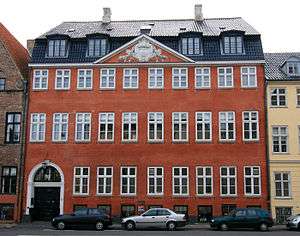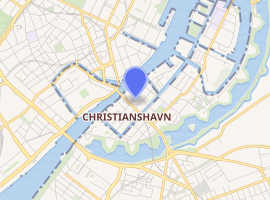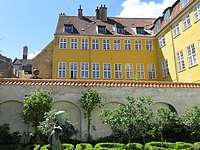Behagen House
The Behagen House is a Neoclassical townhouse located at Strandgade 26 in the Christianshavn neighbourhood of Copenhagen, Denmark. The building was listed on the Danish registry of protected buildings and places in 1918.
| Behagen House | |
|---|---|
Behagens Gård | |
 The building seen from across the street | |

| |
| General information | |
| Architectural style | Neoclassical |
| Location | Copenhagen, Denmark |
| Country | Denmark |
| Coordinates | 55°40′26″N 12°35′24″E |
| Completed | 1769 |
| Client | Gysbert Behagen |
| Design and construction | |
| Architect | Unknown |
History

Two houses similar to the neighbouring Sigvart Grubbe House at No. 28 were built at the site by Sigvart Grubbe in 1626.
In 1759, Gysbert Behagen, a wealthy merchant, acquired one of the two houses. In 1764, he obtained a royal licence to establish a sugar refinery in the yard.[1] In 1768, Behagen also acquired the other house and in 1669 he undertook a comprehensive renovation of his properties, merging them into one building. Behagen lived there until his death in 1783. In 1791, the house was acquired by Jeppe Prætorius, another merchant. In 1796, it was subject to another renovation.[2]
Later notable residents include supreme court attorney and politician Orla Lehmann who lived there in 1847-48. He was one of the fathers of the Danish constitution of 1849. Carl Joakim Brandt, a priest, church historian and literary historian, lived on the ground floor in 1876-79. The painter Frants Henningsen lived on the second floor in 1890–94. The philosopher and professor Harald Høffding lived on the second floor in 1906–08
Architecture

The Neoclassical townhouse seen today is 10 bays wide and consists of three storeys, a cellar and a Mansard roof with black-glazed tiles. The central triangular pediment above the third floor features a cartouche with the letter 'B' (for Behagen) and the year '1769'.

The building contains a mural from about 1771 featuring a royal hunting scene. It depicts Christian VII accompanied by Johann Friedrich Struensee and Queen Caroline Matilda during a par force hunt in what is believed to be an imaginary setting although it has been speculated that Selsø lake and manor house may have served as an inspiration.[3] The artist is unknown. Christian VII revived par force hunting in August 1767 but the practice was abolished in 1777.
References
- "Gysbert Behagen". Gyldendal (in Danish). Retrieved 13 September 2015.
- "Strandgade 26". indenforvoldene.dk (in Danish). Retrieved 28 May 2020.
- "Jagtens ophør, Buffon og gavegivning til Europas adel (1700 tallet)". Verasir.dk (in Danish). Retrieved 13 September 2015.